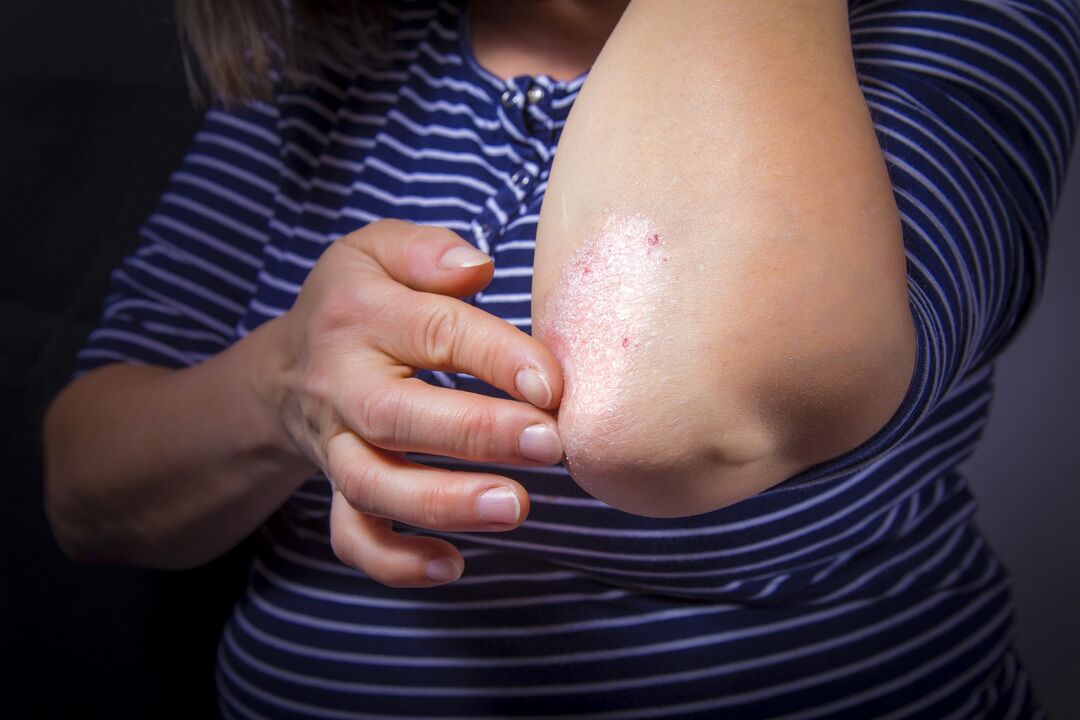
causes of psoriasis
Is psoriasis contagious?
Is psoriasis hereditary?
- psychological trauma and chronic stress conditions;
- past infectious diseases;
- skin damage;
- some medications;
- hormonal changes in the body;
- Allergies (e. g. citrus fruits, eggs, chocolate can aggravate the condition);
- alcohol poisoning;
- Even climate change.
Symptoms of psoriasis
- Stearic stain phenomenon - a large number of silver-white scales are layered and easily separated when scratched;
- Symptoms of psoriatic lamellae are an oozing surface composed of stratum spinosum, which opens after exfoliation of the underlying layer of keratin laminae;
- "Blood dew" phenomenon - after the psoriasis membrane falls off, the surface capillaries are exposed in the form of small blood spots
stages of psoriasis
Types of psoriasis
- Patchy psoriasis appears as pale pink, weakly infiltrated spots. Reminds me of toxoderma.
- Irritant psoriasis - occurs due to exposure of the skin to aggressive environmental factors (sunlight, cold, heat) and irritating medications. The plaques become more intense in color, increase in size, rise higher than the surface of the skin, and form red bands along the edges.
- Seborrheic psoriasis - usually occurs in people with seborrheic disease. The clinical manifestations are very similar to seborrheic eczema.
- Exudative psoriasis is common. Occurs due to excessive secretion of inflammatory fluid - exudate. It saturates scale clusters, turning them into scaly shells.
- Psoriasis on the palms and soles of the feet appears either as common plaques and papules or as hyperkeratosis formation similar to calluses and calluses.
- Follicular psoriasis is quite rare. The rash consists of white miliary nodules with a funnel-shaped depression in the center.
- Mucosal psoriasis is also rare. Occurs on the mucous membranes of the mouth and bladder. Appears as a gray-white area with a red border
- Summer - aggravation of the condition due to exposure of the skin to the sun;
- Winter - occurs due to extreme cold affecting the skin.
- Localized psoriasis – accounts for less than 20% of the body’s skin;
- Common - more than 20%;
- Systemic - the entire skin is affected.
forms of psoriasis
- Pustular psoriasis. It is characterized by the presence of plaques with cortical scales and filled with exudate. If the skin is damaged due to scratching or self-injury in the folds of the body, the rash becomes moist. They can cause itching and burning and cause physical discomfort. This type of disease is more common in people who are overweight, have hypothyroidism, and have diabetes.
- Pustular (systemic) form. It has a classic developmental pattern, starting from a single vesicle and developing into a plaque. The lesions are symmetrical and can affect any part of the body. The severe course of this form of psoriasis is characterized by the development of intraepidermal pustules. They can combine to form a "festering lake". Pustules do not open on their own because they are protected on the outside by a dense brown crust.
- Arthropathic forms. In the most severe form of psoriasis, changes affect the small joints first and then the larger joints, including the spine. This is expressed through pain symptoms and their deformations. There may be joint fusion and loss of mobility. Against the background of this form of psoriasis, other conditions appear: ankylosis, osteoporosis, which can lead to disability.
complication
- Psoriatic joint arthritis. About 30 percent of people with psoriasis will develop psoriatic arthritis in their lifetime, which is characterized by joint stiffness, pain, and swelling. The disease can progress to the point of joint destruction. Psoriatic nail lesions and onycholysis occur in 80-90% of patients.
- psoriatic erythroderma;
- Systemic pustular psoriasis;
- Autoimmune diseases (ulcerative colitis, Crohn's disease);
- male erectile dysfunction;
- Metabolic syndrome refers to the comprehensive manifestation of visceral obesity, insulin resistance and dyslipidemia.
How is psoriasis diagnosed?
psoriasis treatment
Advice on eliminating disease symptoms
- Avoid skin injury;
- Avoid hypothermia;
- break bad habits;
- Avoid stressful situations;
- Prompt treatment of infections and accompanying diseases;
- Avoid prolonged exposure to direct sunlight.
- Use dye- and fragrance-free products;
- Choose a mild shampoo;
- Avoid using rough sponges, creams, and gels with abrasive particles;
- Avoid using hard soap as it can overly dry the skin;
- Adjust water temperature to keep warm;
- Stay in the water for no more than 10-15 minutes;
- Use a soft towel and do not rub or scratch the skin.
Prevent psoriasis
- People who have relatives with psoriasis;
- People who frequently and continuously damage their skin;
- Have chronic infection;
- neurological disorders;
- Endocrine disorders.


















